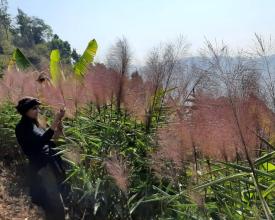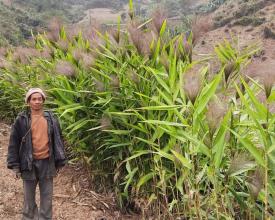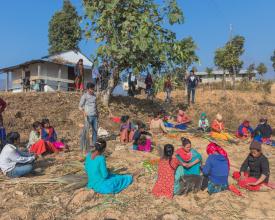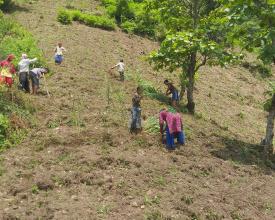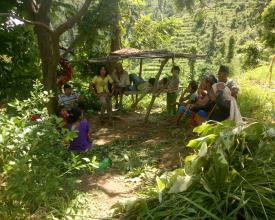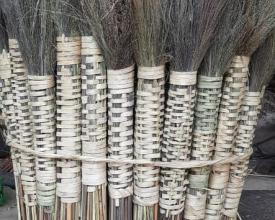
Création d'une entreprise sociale de bio-ingénierie
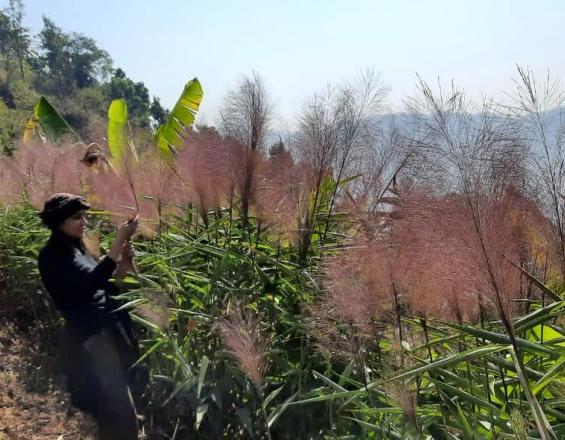
Les basses collines du Népal sont géologiquement jeunes et tectoniquement actives, ce qui pose d'énormes problèmes de géo-catastrophes telles que les glissements de terrain, l'érosion des sols et la dégradation de l'environnement. La région abrite également des communautés tribales qui, en plus d'être exposées aux risques environnementaux, sont confrontées à toute une série de problèmes de subsistance liés à une marginalisation socio-économique historique.
Afin d'atténuer les catastrophes naturelles telles que les inondations et les glissements de terrain qui sont fréquents sur les terrains vallonnés, cette solution basée sur la nature vise à planter des genêts et des bambous sur les terres dégradées et les zones sujettes aux glissements de terrain, afin de sauver les ménages des communautés à risque tout en répondant à leurs problèmes économiques en les formant à l'entreprise sociale et en trouvant un marché pour les biens produits à partir de ces cultures de rapport plantées.
Le genêt à balai et le bambou sont capables d'atténuer les glissements de terrain et représentent un énorme potentiel financier, car leurs sous-produits tels que les balais, le biocarburant, le papier et l'artisanat sont très demandés sur le marché mondial.
Contexte
Défis à relever
Les principaux défis auxquels nous avons été confrontés sont les suivants
Environnement : les plantations ont dû être réalisées sur des terrains où les glissements de terrain étaient fréquents et où le sol était meuble, ce qui présentait un risque d'accidents du travail. La plantation a donc dû être réalisée avec beaucoup de précautions.
Social : Comme la solution exigeait que les bénéficiaires passent deux mois à la plantation et quelques semaines dans des ateliers de renforcement des capacités, cela les a privés des revenus qu'ils auraient pu obtenir en faisant des travaux manuels pendant cette période.
Économique : Comme il s'agit d'un projet pluriannuel, réalisé par une organisation ou un groupe nouvellement créé, la collecte de fonds a été difficile.
Emplacement
Traiter
Résumé du processus
L'organisation qui facilite cette solution joue un rôle essentiel en reliant ces blocs de construction et en les rendant dépendants les uns des autres.
Au cours de la phase pilote du projet, la sensibilisation des communautés s'est faite à grande échelle afin d'interagir et d'enrôler les bénéficiaires dans le projet et de créer des alliances. Les bénéficiaires et l'organisation chargée de la mise en œuvre ont travaillé directement avec ces alliances à différents niveaux afin d'assurer leur implication directe dans la réussite de cette solution.Le comité coopératif qui a été formé avant la phase de mise en œuvre pour la planification, la gestion, la mise en œuvre et la commercialisation des produits est composé de la communauté bénéficiaire et des alliances.
Blocs de construction
Participation de la communauté
Les communautés vivant dans ces paysages sont directement impliquées dans toutes les phases du projet : sélection des ménages, sélection des zones, plantation et supervision de toutes les activités. Le projet encourage la participation active et l'implication dans les processus de prise de décision.
Facteurs favorables
- Sensibilisation de la communauté, pour qu'elle prenne conscience du problème
- Fiabilité des connaissances indigènes sur les solutions basées sur la nature
- Compréhension du fait que le projet est dans l'intérêt des donateurs nationaux et mondiaux, mais qu'il devrait en fin de compte être conforme aux priorités locales, régionales et nationales.
- La confiance entre la communauté et l'organisation a dû être développée.
Leçon apprise
Lors de l'élaboration de ce projet, nous nous sommes fortement appuyés, et dans certains cas uniquement, sur le savoir local et l'artisanat ancestral. Mais au cours du processus, nous nous sommes rendu compte que certains des composants n'étaient pas pertinents et qu'il fallait les équilibrer avec des techniques et des technologies modernes.
Nous avons également appris que les intérêts de la communauté et la volonté politique locale ne coïncident pas toujours.
Alliances
Diverses alliances ont dû être conclues pour assurer la réussite du programme. Une collaboration a été nécessaire entre les parties prenantes suivantes :
- les autorités administratives et les gouvernements locaux et provinciaux
- Groupes sociaux tels que les clubs de jeunes, les groupes de femmes, les comités agricoles
- Comités de protection des forêts et des terres
- Entreprises privées locales, régionales et nationales
- Divers experts, chercheurs et universitaires du secteur
Facteurs favorables
Étant donné que cette solution implique des activités à plusieurs niveaux (planification, mise en œuvre, conservation, suivi, commercialisation et promotion), il devient essentiel de rassembler toutes les parties prenantes et de les relier entre elles par des objectifs communs et les responsabilités qui leur sont attribuées par l'État et la société.
Leçon apprise
- Les parties prenantes n'ont pas toujours les mêmes intérêts et objectifs
- Les conflits entre les parties prenantes des alliances sont fréquents en raison de leurs intérêts.
- La rigueur des aspects juridiques dans les relations avec la bureaucratie locale est nécessaire.
- La conscience de l'intérêt général doit être évoquée à tous les acteurs, encore et encore.
L'agriculture coopérative pour des moyens de subsistance durables
Un soutien institutionnel est nécessaire pour que les bénéficiaires puissent promouvoir les produits qu'ils fabriquent grâce à cette solution sur les marchés locaux, régionaux et nationaux. Étant donné qu'un seul agriculteur ne peut répondre à la demande du marché et que les distributeurs recherchent des quantités importantes, une coopérative opérationnelle doit être créée au niveau local. Cette coopérative a pour mission de collecter les produits, de négocier le prix avec le distributeur, de superviser la fabrication et de distribuer les bénéfices.
Facteurs favorables
La demande de balais et de produits connexes est élevée sur le marché local, national et international et les distributeurs achètent toujours en gros. En appliquant les méthodes de l'agriculture coopérative, il sera plus facile pour un agriculteur isolé de fournir son produit et d'en obtenir un prix raisonnable. Au lieu de s'adresser à des agriculteurs isolés, les distributeurs négocient les prix avec le comité de la coopérative, ce qui garantit également des prix plus stables et plus rentables pour leurs membres.
Leçon apprise
- La direction du comité coopératif doit être confiée à des personnes de la communauté qui connaissent bien le marché.
- La coopérative doit être bipartisane et équitable pour tous.
Impacts
Les impacts créés par la mise en œuvre de cette solution dans la phase pilote sont les suivants :
- Atténuation des catastrophes géologiques telles que les glissements de terrain, les crues soudaines, l'érosion des sols et la dégradation générale de l'environnement.
- Amélioration des moyens de subsistance des communautés tribales et marginalisées vivant à proximité de la zone grâce à la vente de produits issus des cultures commerciales.
- Promotion des connaissances tribales et indigènes
Bénéficiaires
Les communautés tribales vivant dans ces régions qui ont été historiquement marginalisées tant sur le plan politique qu'économique. La plupart des bénéficiaires vivent sous le seuil de pauvreté. Lors de la réalisation du projet, la priorité a été donnée aux ménages dirigés par des femmes.
Objectifs de développement durable
Histoire

L'homme sur la photo a hérité d'une terre après le décès de ses parents. Comme il était jeune au moment de l'attribution, il s'est vu attribuer la partie dégradée par ses frères aînés, qui lui ont enlevé la terre arable. En raison de la nature meuble du sol, ses terres subissaient de fréquents glissements de terrain et ne se prêtaient à aucune plantation. Il s'est inscrit à ce projet et s'est familiarisé avec la plantation de genêts grâce à l'atelier organisé par cette organisation. Depuis, il n'y a pas eu un seul glissement de terrain et il a pu produire et vendre des genêts sur le marché, ce qui lui a permis de gagner un revenu. Grâce à cette plantation, le sol est devenu moins meuble et ses propriétés se sont améliorées.
